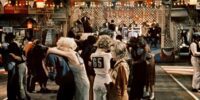Neill Blomkamp’s making me a movie star
When I was first introduced to the music of South African Hip Hop Group Die Antwoord, I was blown away. Their sound, their look, their attitude, they ticked a lot of boxes for me. I still listen to their music a lot today, and I love their artistic style. When I heard the alien-like Yolandi sing about Neill Blomkamp making her a movie star in one of my favourite tracks ‘Baby’s on Fire’, I thought it was just because of the South African connection. I didn’t realise he was making her, and her musical partner Ninja into actual movie stars. But then I stumbled upon Chappie on Netflix, and was blown away all over again. After enjoying District 9, I was sure that Chappie would be a great film anyway. But to find that it stars Die Antwoord as well, and not just in bit parts, but as main characters made me very excited to tune in. I wasn’t disappointed.
Chappie is a fantastic Sci-Fi film that serves comedy and heartbreak in equal measures with action and gore. The story is great, not quite as thought-provoking as District 9 perhaps, but this is made up for in the visual style of the film, the soundtrack, and the action. I do think that if you are not a fan of the group, then you may not get a lot from this film. You could argue that it’s a two-hour long music video for Die Antwoord, but as a major fan of them, that’s not a bad thing for me. But to me, it is so much more than that. Chappie has a conscience. Chappie has a heart. And Chappie can save us. Join me as I highlight some of the reasons why I think Chappie is an excellent Sci-Fi film.
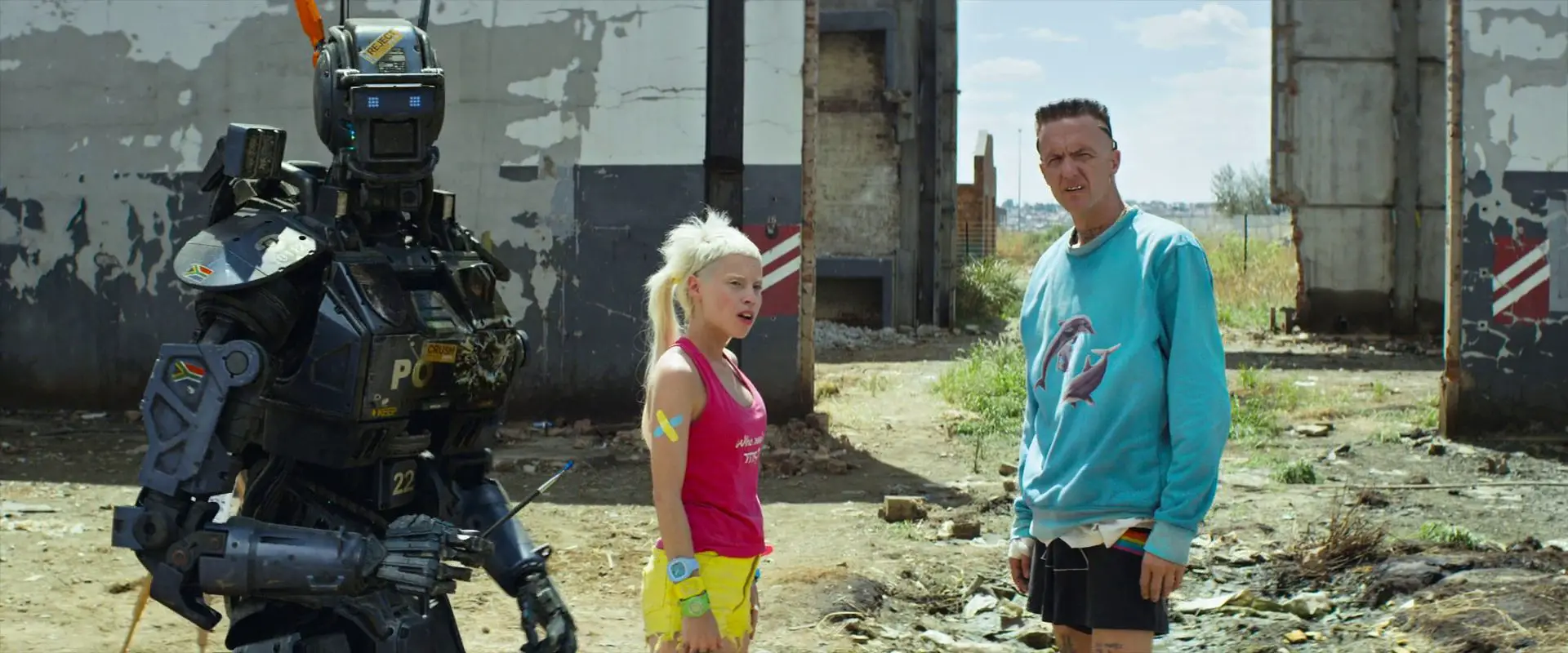
Let me start by talking about the style of this film. Chappie is set in a world molded by Die Antwoord’s artistic flare and personal style. If it wasn’t for the futuristic robots, violence and crime, one could believe this was in fact a behind the scenes look at Yolandi and Ninja’s home life. Guns are modified with bright happy colours, the walls of their hideout is covered in their easily recognisable style of art, and the costuming is lifted directly from their music videos. The film really hits the Zef mark, the style Die Antwoord live by. Zef means ‘Poor but fancy’. You can’t afford the rent this month but you do have the latest Adidas high tops. And Yolandi and Ninja’s hideout in the film screams this statement, as do their outfits. It fits with their personal style, and also with the film. They are criminals, living in an abandoned warehouse-type building. They can’t afford a real home but they can steal all the PS4s and bling they can carry. Their world may be scary, but the vibrant art style makes it seem less so.
On the flip side to their world, we have the not so futuristic setting of the robotics company Tetravaal, a name Blomkamp fans may recognise from his short film of the same name, and the birthplace of Chappie. This world is the opposite to the criminal world. You can tell that no expense has been spared for the company headquarters, but it is cold and lifeless. Ironic for the place creating artificial life. It’s a harsh contrast, and works well in highlighting the two worlds at war in South Africa. The uber-rich versus the poor. It blurs the lines of good and evil, and makes the viewer question whose side they would be on. Die Antwoord may be the ones stealing and killing, but their world appears preferable to that of main engineer Deon. His home life consists of work and robot companions. There is no fun in Deon’s life, no colour. He is the perfect opposite of Yolandi and Ninja, making them two very different parents for Chappie to look up to. He becomes the perfect blend of gangster and good guy thanks to the dynamic parenting of the two parties.
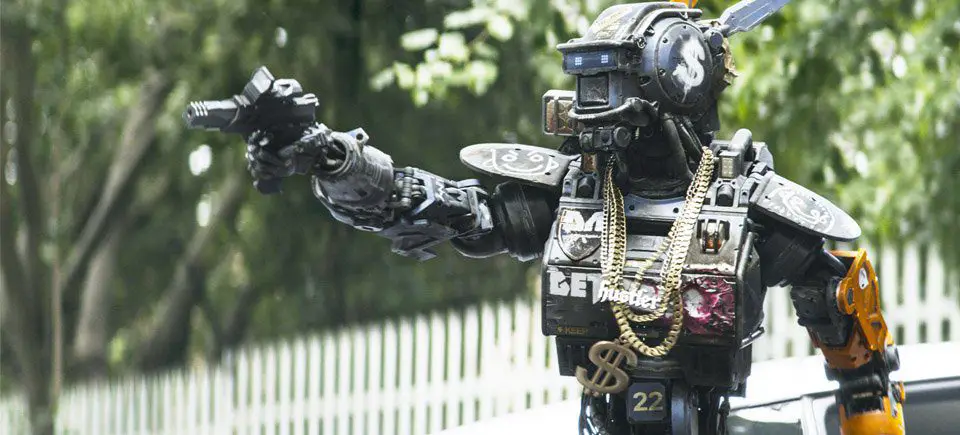
Just to touch on the way Chappie looks himself too, it’s worth mentioning that there are numerous points in this film where I had to remind myself that he is CGI. I know special effects are awesome these days, but Chappie somehow takes this to another level. The way he interacts with the world and the people around him, and even just the way he moves, is an incredible achievement from the special effects team. I genuinely believed he was a real, physical creation, built for the film and somehow worn by a very slim actor. But he isn’t, he’s CGI. It’s the kind of effects that I still talk about to this day from the first Jurassic Park film. That T Rex was really there, I swear. And Chappie is just as impressive. At no point does the illusion break, you never think ‘Ah ok now I see that it’s CGI’. The quality is ongoing throughout the film, and Chappie genuinely feels like he’s right there amongst the action. Even if you’re not a fan of Die Antwoord, the special effects will impress you.
Another winning element for this film is the soundtrack. Understandably, there is a lot of Die Antwoord tracks throughout the film. But even if you’re not a fan, the music suits the look and feel of the film. Their heavy basslines and Yolandi’s unique voice paired with Ninja’s intense rapping works perfectly with the imagery on screen. Their sound matches the visuals, perhaps because the film looks so much like their style. This adds to the feeling that this film is real life. Why wouldn’t Die Antwoord listen to their own music? It’s great music! And it works brilliantly with the action and violence of Blomkamp’s vision of South Africa. Die Antwoord are the perfect sound for his vision as their core sound matches his core idea of the not-so-distant future South Africa. Their music is unpredictable, and chaotic. It sometimes shows violence and anger, whilst having the odd smatter of love here and there. And that’s how Blomkamp imagines his Chappie universe. Violent, unpredictable and with a glimmer of hope within.
Hearing ‘Cookie Thumper’ was a particular stand out moment for me as it’s not only one of my favourite tracks of theirs, but it also worked so effortlessly with the scene it was playing over. Parts of the film really do come across as scenes lifted directly from one of their music videos. As well as all of the Die Antwoord, there is also an original score from soundtrack legend Hans Zimmer. This complements the Die Antwoord tracks wonderfully and helps build up the tension and drama as the film reaches its action-packed finale. Some of the tracks featured on the score actually have elements of Die Antwoord included, leading me to believe Zimmer and his team took inspiration from their sound too. ‘A Machine That Thinks and Feels’ for example has the same haunting, music box style melodies as Die Antwoord’s ‘Alien’. They could be two separate halves of the same song. The score is beautiful and truly adds a lot of depth and feeling to the film.
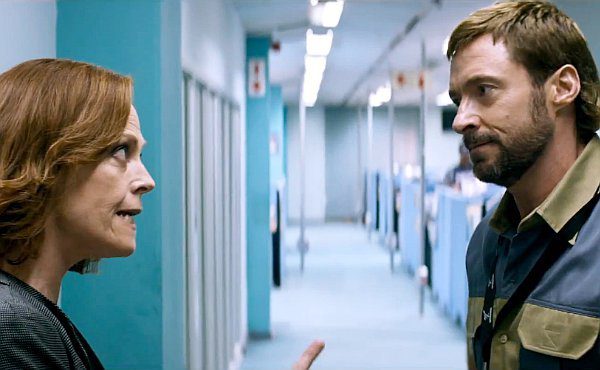
Onto the cast, Chappie has an extraordinary mix of a-list Hollywood greats and newcomers, again giving that sense of chaotic unbalance. One side versus another, the super famous and the unknown. It helps establish the idea of the rich versus the poor. On the rich side, we have Hollywood royalty Sigourney Weaver and Hugh Jackman. On the poor side, we have Die Antwoord and Brandon Auret. The household names against the relatively unknown, it’s an excellent mixture of the two. Yolandi, Ninja and Sharlto Copley who voices Chappie steal the show, leaving the big names to the supporting characters. Jackman plays Vincent, the man who created the first police robot which was rejected when Deon, played by Dev Patel, created the Scout model that Chappie is. Weaver is the head of Tetravaal, giving the orders from above and playing the smallest part in comparison to the others. It’s an interesting choice to have names so high up in the Sci-Fi world such as Weaver and Jackman to play smaller parts in the film. But it works, it’s refreshing to see Jackman play the bad guy for a change. And Weaver’s role is reminiscent of the part she played in Cabin in the Woods, which I just loved.
As for Yolandi and Ninja, they play their respective parts to perfection. I guess it was easy for them as they do just kind of play themselves. Or at least the characters they have created for themselves as part of the Die Antwoord brand. Both are criminals, not afraid to kill to get what they want. But when Chappie is introduced into their lives, Yolandi becomes a mother figure to him, showing a much softer, more maternal side. Whereas Ninja takes on the strict and aggressive Father role, only enhancing his bad guy vibe. He does eventually change his ways slightly, apologising for hurting Chappie, but he’s still pretty bad in comparison to Yolandi. Seeing the two together as these underground gangsters really is a treat for their fans. It’s like a sneak peek into the lives of Die Antwoord, as they would have us believe this is who they really are, minus the robotic child. Yolandi does outshine Ninja in my opinion, but I may be biased as I adore her. They both play the parts well and give believable performances throughout the film.

As for the ‘Man’ himself, young Chappie, Sharlto Copley steals your heart as soon as the robot he voices utters his first word, ‘Chi-ken’. Every word Chappie says is adorable. Whether he’s talking about his newfound Mommy Yolandi, describing his blings, or even shouting at sluts for stealing his daddy’s car. Everything he says makes you smile. Since I was a child, I’ve wanted RoboCop as a companion. 30 years of wanting this robo-friend has come to an end, as I now want Chappie. He’s my new favourite robot, and a major factor of that is Sharlto’s voice. His mispronunciation of words and phrases are both hilarious and heart-warming. From his insistence of ‘Chappie no cimes!’ to his attempt at swearing with ‘Fuckmother’, Chappie’s language is an integral part of the film and adds the humour to many of the scenes. But as well as humour, Chappie’s innocence also lends itself to some of the sadder scenes too.
After he is attacked by a gang of youths following Ninja leaving him in the real world to see how good he has it at home, we get a heartbreaking scene with him and his mother Yolandi. She asks who did this to him and he tries to explain with his limited vocabulary. ‘And they threw fire, even though I said please’ brings a tear to your eye as he explains he was petrol bombed despite asking them to stop. The violent scene itself is hard to watch as Chappie pleads with the violent gang ‘Why you do this? Chappie doesn’t like it’. He then goes on to repeatedly beg them ‘Please, may you not’ as they hurl rocks and abuse at him. It’s really heart wrenching to watch. Something about the way he speaks makes him infinitely childlike, despite being a tall metal machine. It brought back those familiar emotions of when Murphy is beaten almost to death towards the end of Robocop. Robot violence really gets me down! It’s also heartbreaking to see Chappie try to understand why his maker would create him in a body that is going to die. Chappie is the main attraction in this film and credit has to go to Sharlto for bringing him to life with such warmth and humanity. Making a machine human-like and someone the audience cares about is no easy task, but he knocked it out of the park with his portrayal of Chappie.
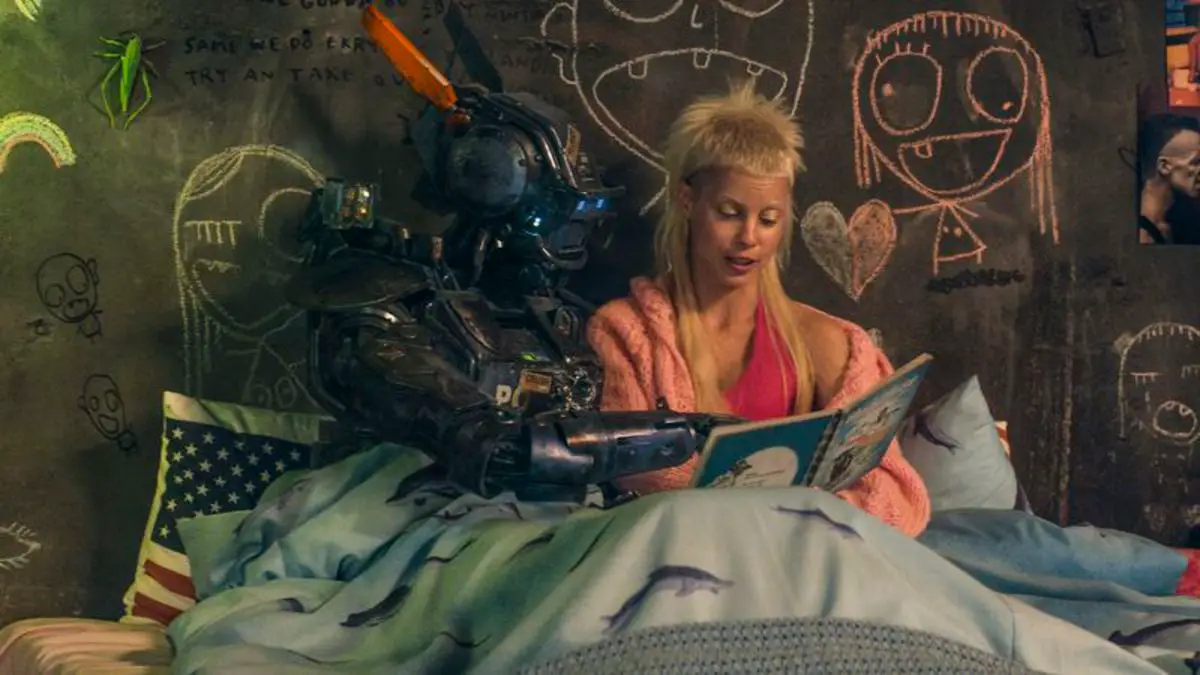
Chappie may not have the story depth of District 9 or Elysium, but what it lacks in that department, it makes up for in style, action, and emotional conflict. Chappie is the robot with consciousness, and his love for painting and blings and his mother is palpable. It’s an excellent combination of the criminal underworld facing off against the super-rich, and then in the middle of this war is a child. A mechanical child that is shown both sides of the coin and given the choice to decide how he wants to live. He sees the good in both sides, and the bad in both sides too. He learns from both sides and he shows traits of both sides in equal measure. But at his core, Chappie’s most redeeming feature is his humanity. He has compassion and empathy, more than any of the humans in the film in fact. Chappie is love and innocence, he is forgiveness and truth. And most importantly, Chappie no crimes.

